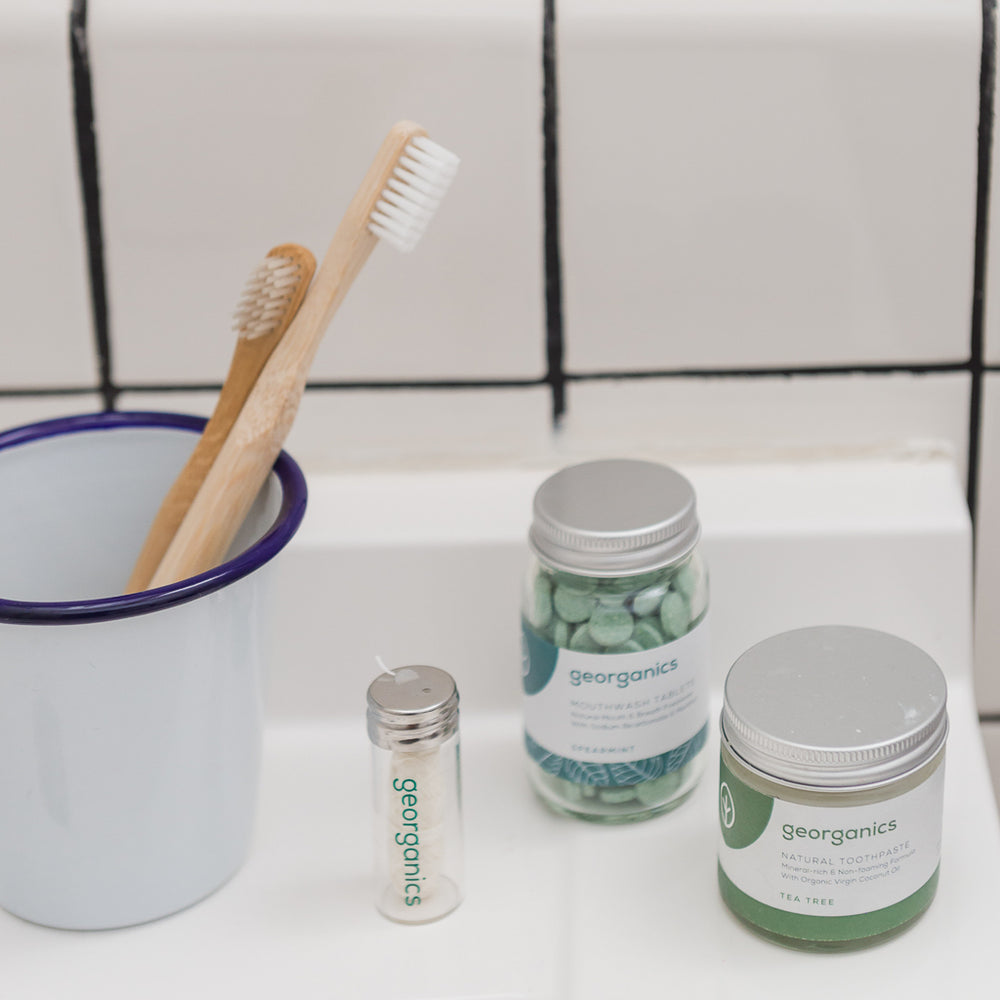Have you ever wondered where your favorite Elmo toothbrush from childhood ended up, or all those freebies you picked up from dentist visits over the years? The bad news—they likely all still exist somewhere in a landfill (unless they were incinerated). When you add up all of the oral hygiene products you go through a year (3-4 toothbrushes, 122 yards of floss, half a dozen toothpaste tubes and mouthwash bottles), and multiply that number by how many years you’ve been brushing your pearly whites, it adds up to...a lot. The good news is that there are plastic-free alternatives for each step of your dental routine that will keep your teeth and gums healthy and reduce waste.
Toothbrush
Consider switching to a compostable toothbrush with a bamboo handle. The bristles are generally made from nylon and need to be removed before you compost the handle or you can reuse old brushes for cleaning or turn them into garden markers. If you still want to use your electric toothbrush or have some old plastic brushes past their prime, consider mailing them into TerraCycle for recycling. They also accept floss containers, toothpaste tubes and nylon bristles as part of their program with Colgate.
Toothpaste
Whether you want to experiment with a DIY toothpaste, or prefer to buy it premade, there are quite a few plastic-free options. For minimal effort, just sprinkle some baking soda onto your brush. Baking soda is mild abrasive and helps whiten teeth and freshen breath. If you find it too salty, mix in some peppermint essential oil. If you prefer a paste, whisk it with some sunflower or coconut oil until it forms a paste. And if you’d just rather not, buy your paste in a recyclable container—Georganics sold in a glass jar and David’s sold in a metal tube are two of our favorites. Be sure to thoroughly clean the empty container or tube before you recycle it.
Floss
Plastic floss can not only harm wildlife, it can harm our health. To achieve less friction and more “glidability,” floss is often coated with perfuoroalkyl substances (aka PFAS) which have been linked to cancer and heart disease. Ditch plastic floss for biodegradable silk floss packaged in a refillable glass vial. You also might want to look into a water flosser. I love my cordless Waterpik, and while it’s made from plastic, it's long lasting and replaces disposable plastic floss. They can also be helpful for cleaning dental hardware like braces. My water flosser has made it much more likely that I’ll floss every night, but I still use silk floss every few days.
Fresh Breath
Like toothpaste, there are quite a few DIY mouthwash recipes for fresh breath—most use a combination of baking soda or hydrogen peroxide with essential oils. You could also try mouthwash tablets that come in a glass jar. You drop one tablet into a glass of water and swish it around in your mouth. Another low waste option is oil pulling. Most people use coconut oil, but you could also use olive, sunflower or sesame oil. Swishing one of these oils in your mouth for 15 minutes helps destroy bacteria and freshen breath.
Whitening
Speaking of oil pulling, it also whitens teeth! Some other options are using a toothpaste with activated charcoal—the charcoal binds to plaque and removes stains—or use naturally abrasive baking soda. I like to keep a jar of baking soda mixed with olive oil in my bathroom to brush my teeth and whiten my smile once a week. I notice a difference after just one use!
It’s always a good idea to consult your dentist whenever you plan to make a change to your oral hygiene, and don’t be afraid to decline their plastic freebies when you visit for a cleaning. Also, if you still have your retainer (and it fits), remember to wear it every night! Your future self will thank you.

